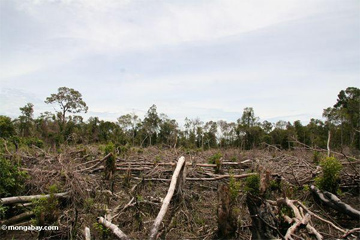Indonesian President Susilo Bambang Yudhoyono has issued new regulations, which will allow underground mining in protected areas, according to the Jakarta Post. The new rules will also allow power plants, renewable energy, and transportation such as toll roads in protected forests.
“We are now waiting for a presidential decree to bring the regulations into force. A number of firms have applied for mining permits in protected forest areas,” a senior official at the Forestry Ministry, Bambang Mulyo, told the Jakarta Post Monday.
Forestry Minister Zulkifli Hasan defended the move, saying that strict environmental regulations will apply to the mines.
 Deforestation of peatland forest in Indonesian Boreno. Photo by Rhett A Butler. |
“The regulation will only allow mining activities to operate under the forest areas. So this is not for open mining and hopefully will only bring a minimum impact to the ecosystem in protected forests,” he said as reported by the Jakarta Post.
“Because of the lack of regulations, most of the areas were being exploited without considering reforestation,” Hasan added. “In addition, they will be obliged to pay taxes for operating mines under the protected forest.”
The move is being made in part to attract more mining investment through clarifying regulations, cutting red tape, and allowing mining in numerous areas long off-limits.
Indonesia loses more than a million hectares of forest every year to logging for timber and plantations such as oil palm and pulp, as well as fires. Largely because of this widespread deforestation, Indonesia is number three in carbon emissions after China and the United States.
Recently the Indonesian government stated that it would reduce greenhouse gas emission by 26 percent in a decade. It has said that 14 percent of this would be related to deforestation. The government also plants to plant a billion trees on degraded lands.
Covering over 17,000 islands, Indonesia is home to a large number of well-known endangered species such as the Sumatran tiger, both the Bornean and Sumatran orangutan, the Sundaland clouded leopard, the wild cattle anoa, the Asian elephant, as well as both the Sumatran and Javan rhino. Many of these species last strongholds are in the nation’s protected forests.
Recently a government official estimated that only half of Indonesia’s species are known.
In all, scientists have currently catalogued over 30,000 species of plants and over 3,000 mammals, birds, reptiles, and amphibians in Indonesia. Its number of recorded mammals—515—is second only to Brazil.
Related articles
Indonesia to target New Guinea for agricultural expansion
(02/22/2010) Indonesia will target its last frontier — its territory on New Guinea — as it seeks to become a major agricultural exporter, reports the AFP.
Illegal loggers hit community reforestation project in Indonesia, spurring questions about REDD
(02/22/2010) Illegal loggers are targeting community-managed forests in South Sumatra, renewing questions over forestry governance and law enforcement as the Indonesia prepares to capitalize on payments for conservation and reforestation under a proposed climate change mitigation mechanism known as REDD, reports the Jakarta Press.
Commodity trade and urbanization, rather than rural poverty, drive deforestation

(02/07/2010) Deforestation is increasingly correlated to urban population growth and trade rather than rural poverty, suggesting that measures proposed to reduce deforestation will be ineffective if they fail to address demand for commodities produced on forest lands, argues a new paper published in Nature GeoScience.
Half of Indonesia’s species remain unknown
(02/02/2010) Incorporating 17,000 tropical islands, Indonesia is one of the world’s richest areas of biodiversity. However, according to the Jakarta Post, over half of this biodiversity remains unrecorded with only 20 of the more than 400 regencies in the country recording species.
Little more than 10,000 hectares of rainforest remains on Java
(01/24/2010) From 2003-2006, Java lost approximately 2,5000 hectares a year (10,000 hectares of forest in total) according to the Forestry Ministry. Despite the rate of loss being far lower in Java than other Indonesian islands (such as Borneo, Sumatra, and Sulawesi), Java is particularly threatened because there is so little forest left. If the past rate of deforestation occurs from 2007-2010 then by the end of the year conservation organization Pro Fauna predicts only 10,000 hectares of rainforest will remain on the island, leaving a number of unique and endangered species in deep trouble.
Cheerios maker linked to rainforest destruction
(01/19/2010) An activist group linked General Mills to destruction of rainforests in Southeast Asia in dramatic fashion on Tuesday, when it unfurled a giant banner, reading “Warning: General Mills Destroys Rainforests”, outside the company’s Minneapolis headquarters building.
Indonesian government report recommends moratorium on peatlands conversion
(01/19/2010) A study issued by Indonesian government recommends a moratorium on peatlands conversion in order to meet its greenhouse gas emissions target pledged for 2020, reports the Jakarta Post. The report, commissioned by the National Development Planning Agency (Bappenas), says that conversion of peatlands accounts for 50 percent of Indonesia’s greenhouse gas emissions but only one percent of GDP. A ban on conversion would therefore be a cost-effective way for the country to achieve its goal of reducing carbon emissions 26 percent from a projected baseline by 2020. But the recommendation is likely to face strong resistance from plantation developers eager to expand operations in peatland areas. Last year the Agricultural Ministry lifted a moratorium on the conversion of peatlands of less than 3 meters in depth for oil palm plantations. Environmentalists said the move would release billions of tons of carbon dioxide.
REDD must address corruption to save rainforests in Indonesia, says report

(01/13/2010) The Indonesian government squandered billions of dollars in funds set aside for reforestation through corruption and mismanagement in the 1990s, raising important questions as the country prepares for the influx of money from a proposed climate change mitigation scheme known as REDD+ (reduced emissions from deforestation and degradation), warns a new report released Tuesday by the Center for International Forestry Research (CIFOR), a forest policy research group.
Indonesia to plant and restore vast area of forest to reach emissions target
(01/07/2010) Indonesia will rehabilitate degraded forests and plant millions of hectares of new forests to meet its target of reducing greenhouse gas emissions 26 percent from projected levels by 2020, reports Reuters.
Bridge development in Kalimantan threatens rainforest, mangroves, and coral reef
(01/03/2010) Balikpapan Bay in East Kalimantan is home to an incredible variety of ecosystems: in the shallow bay waters endangered dugong feed on sea grasses and salt water crocodiles sleep; along the bay proboscis monkeys leap among mangroves thirty meters tall and Irrawaddy dolphins roam; beyond the mangroves lies the Sungai Wain Protection forest; here, the Sunda clouded leopard hunts, sun bears climb into the canopy searching for fruits and nuts, and a reintroduced population of orangutans makes their nests; but this wilderness, along with all of its myriad inhabitants, are threatened by a plan to build a bridge and road connecting the towns of Penajam and Balikpapan.
Rainforest conservation: a year in review
(12/27/2009) 2009 may prove to be an important turning point for tropical forests. Lead by Brazil, which had the lowest extent of deforestation since at least the 1980s, global forest loss likely declined to its lowest level in more than a decade. Critical to the fall in deforestation was the global financial crisis, which dried up credit for forest-destroying activities and contributed to a crash in commodity prices, an underlying driver of deforestation.
